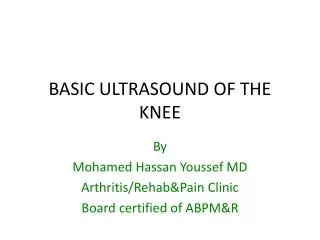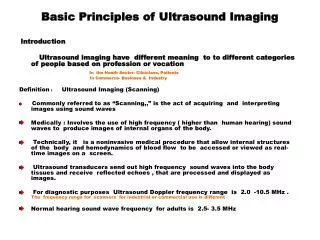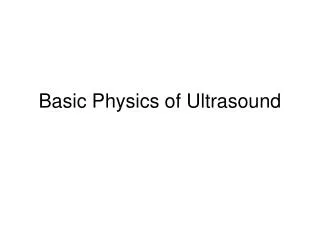Basic Principles of Ultrasound
Basic Principles of Ultrasound. Objectives. Define Scope of Practice Understand Principals Understand Physics Understand Transducers Understand Terminology Understand Artifacts. Scope of Practice. eFAST in Trauma Abdomen Chest. Musculoskeletal/Soft tissue Fracture/dislocations.
Share Presentation
Embed Code
Link
Download Presentation

arich + Follow
Download Presentation
Basic Principles of Ultrasound
An Image/Link below is provided (as is) to download presentation Download Policy: Content on the Website is provided to you AS IS for your information and personal use and may not be sold / licensed / shared on other websites without getting consent from its author. Content is provided to you AS IS for your information and personal use only. Download presentation by click this link. While downloading, if for some reason you are not able to download a presentation, the publisher may have deleted the file from their server. During download, if you can't get a presentation, the file might be deleted by the publisher.
Presentation Transcript
- Basic Principles of Ultrasound
- Objectives • Define Scope of Practice • Understand Principals • Understand Physics • Understand Transducers • Understand Terminology • Understand Artifacts
- Scope of Practice • eFAST in Trauma • Abdomen • Chest • Musculoskeletal/Soft tissue • Fracture/dislocations • Vascular • Access • Blood flow/DVT • Ocular • FB/retinal detachment • Retrobulbar hemorrhage • Genitourinary • Bladder • Ectopic pregnancy • scrotal pain & swelling
- 3-Tiers • Basic • eFAST, MSK, Skin/Soft Tissue, & Vascular Access • Intermediate • Ocular, Renal, Regional Anesthesia, & DVT • Advanced • OB/Gyn, Testicular, Aorta (AAA), Cardiac (Critical Care), & Pericardiocentesis
- Basic Principles • Ultrasound machine and probes create sound waves • Generate waves of vibration from the probe that travel through the tissue of the patient and return to the probe • Received by the machine and interpreted to provide images on screen • Different tissue densities affect the ultrasound beam
- Principles • The intensity of the returning echo determines the brightness of the image on the screen • Strong signals = white (hyperechoic) images • Weak signals or lack of signal all together = black (hypoechoic) images • Tissue densities determine the many shades of gray in between
- Physics • Diagnostic ultrasound uses sound waves in the frequency range 2-20 MHz • Key properties of sound waves: • Frequency is number of times per second the sound wave is repeated • Wavelength is the distance traveled in 1 cycle • Amplitude is distance between peak and trough
- Physics – Parallel Concepts • Conceptually, ultrasound is similar to a laser range finder. • Sound waves sent from the transducer bounce off the object and return. • The ultrasound machine calculates distance to the object from the round-trip time, and creates a grey scale image on the screen.
- What does it mean to me? • Lower frequencies image deep structures, but sacrifice resolution. • Higher frequencies provide better resolution, but sacrifice depth. LOWER FREQUENCY Longer wavelength HIGHER FREQUENCY Shorter wavelength
- Transducer Function • Ultrasound waves are generated by an electric current -> sent to the crystals -> excites the crystals which vibrate -> creating the resulting wave in the tissue • Beam is ~ 1mm
- Transducer Characteristics • The workhorse of the US machine • Sends out sound waves 1% of the time • Listens for echoes 99% of the time • Frequencies are fixed or adjustable • “Footprint” is what touches the patient
- Transducer Use • Hold the probe lightly in your hand • Like a pencil • Small movements equal big changes
- Transducer Use • Probe marker facing the patient’s right or head • Exceptions: cardiac & procedures
- Probe indicator – leading edge Generally to the patient’s head or right side.
- Transducer Choices • Curvilinear Array (Curved Probe) • Freq range (5-2 MHz), 30cm depth • Abdomen, FAST, AAA • Linear Sequential Array (Linear Probe) • Freq range (10-5 MHz), 9cm depth • Vascular access, pneumothorax, regional anesthesia • Phased Array (Sector or Cardiac Probe) • Freq range (5-1 MHz), 35cm depth • Cardiac, eFAST, AAA
- Transducer directions • Rotating • Fanning/Tilting • Rocking • Sliding • Compression
- Transducer directions • Sliding
- Transducer directions • Fanning/Tilting • Compression
- Transducer directions • Rotation • Rocking
- Scanning Planes
- Scanning Planes Sagittal Axial
- Screen Orientation Near Field Receding Edge Leading Edge Far Field
- Image Quality – The 5 P’s • Use Plenty of Gel • Parallel to the table/stretcher • Perpendicular to structure • Pressure (right amount) • Scan in multiple Planes
- Gel & Water Stand-offs
- Ultrasound transmission gel USE LOTS OF IT.
- Image Quality - Machine • Depth: Place the object of interest in the center of the screen • Machine will autofocus to the center of the screen giving it the best resolution • Right side markings show depth in cm • Gain: brightness of the image • Can be adjusted for each scan • Be careful not to use too much or too little gain • Autogain
- Depth Too Little Too Much
- Depth – JUST RIGHT!
- Gain Too Little Too Much
- Gain – Just Right!
- Image Resolution • Spatial Resolution • The ability to distinguish two separate objects close together • Temporal Resolution • The ability to accurately locate structures or events at a specific point in time • Can be improved by decreasing depth & narrowing the sector angle
- Spatial Resolution Axial Lateral The ability to distinguish two objects that are laying side-by-side Dependent upon the beam width Two objects cannot be distinguished if they are separated by less than the beam width High freq = narrow width Low freq = wider width • The ability to differentiate two separate objects in the axial plane • Determined by the pulse length • High freq = short length & better axial resolution • Low freq = long length and poor axial resolution
- Scanning Modes • B-Mode: • Nearly all of your scans will begin and stay in this mode • Organs appear differently based on their tissue densities
- Scanning Modes • M-Mode: • Motion mode provides a reference line on screen • Shows motion towards and away from probe at any depth along that line • Used for detecting fetal heartbeatsand pneumothoracies
- Scanning Modes Spectral Doppler Color Flow Doppler Blue – Away : Red – Towards Power Doppler
- Attenuation • As the ultrasound beam travels through the body, it looses strength & returns less signal • Certain tissue densities cause this effect: • Slow: Bone, Diaphragm, Pericardium & air = bright (Hyperechoic) images • Moderate: Muscle, Liver, Kidney = gray (Isoechoic) images • Faster: Blood, Ascites, Urine = Darker (Hypoechoic) images
- Artifacts • Posterior Enhancement • Reverberation • Edge Artifact • Shadowing • Mirror Image • Comet Tail
- Posterior Enhancement Hyperechoic streaking distal to interface of anechoic structure Not a true artifact
- Reverberation Bouncing of signal from two reflective surfaces Often seen as a “needle artifact” during procedural ultrasound Called “Ring Down artifact” when seen with air in the bowel or soft tissue
- Edge Artifact A distal shadow from the edge of spherical fluid filled structures Scan at different angles to reduce the artifact
- Shadowing Anechoic streaking distal to surface with high reflectivity (behaves like light) Stones Bones
- Mirror Image Appearance of same image on both sides of highly reflective surface Misinterpretation by machine of signal timing puts image where it thinks it “should be” Often seen on cardiac and around diaphragm
- Comet Tail Pathognomonic for excluding pneumothorax
- Questions?

BASIC PRINCIPLES
BASIC PRINCIPLES You cannot sell from an empty wagon! Private sector development of industrial/business parks may be adequate. If not, there is a compelling need for local economic development programs to fill the need. STATUTORY AUTHORITY N.C.G.S. §158-7.1(a) provides:
669 views • 19 slides

Basic Principles of GMP
Basic Principles of GMP. Complaints and Recalls. Sections 5 and 6. Complaints and Recalls. Objectives To identify the key issues in product complaint and recall handling To understand the specific requirements for organization, procedures and resources
659 views • 22 slides

Principles of Ultrasound
Types of Ultrasound. Diagnostic (20,000 Hz 750,000 Hz)Therapeutic (.75 MHz 3 MHz)Surgical (3 MHz 10 GHz)Human ear can hear (16-20,000 Hz). Definition. Ultrasound is a deep penetrating modality capable of producing thermal and non-thermal effectsProduced by an alternating current (AC) flow
878 views • 27 slides

Basic Principles of Assessment
Basic Principles of Assessment. Communicating Assessment Results. Feedback Sessions. Oral or written Comprehensible and useful Need to consider: Purposes of assessment What does it mean to the test taker, education, career…. Should be soon after assessment.
504 views • 5 slides

Basic Principles
Basic Principles. Learning objectives. Understand the basic principles undelying A&T techniques Grasp the motivations and applicability of the main principles. Main A&T Principles . General engineering principles: Partition: divide and conquer Visibility: making information accessible
580 views • 10 slides

BASIC ULTRASOUND OF THE KNEE
BASIC ULTRASOUND OF THE KNEE. By Mohamed Hassan Youssef MD Arthritis/ Rehab&Pain Clinic Board certified of ABPM&R. Knee Joint. Knee Bones. Distal end of the F umer Proximal end of the Tibia Head of the Fibula Patella. Knee Bones. Knee Bones. Movement of Patella Upward
1.01k views • 40 slides

Basic Principles of Ultrasound Imaging
Basic Principles of Ultrasound Imaging. Introduction Ultrasound imaging have different meaning to to different categories of people based on profession or vocation In the Heath Sector- Clinicians, Patients
8.22k views • 17 slides

Basic Principles
NMM Dynamic Core and HWRF Zavisa Janjic and Matt Pyle NOAA/NWS/NCEP/EMC , NCWCP, College Park, MD . Basic Principles. Forecast accuracy Fully compressible equations Discretization methods that minimize generation of computational noise and reduce or eliminate need for numerical filters
567 views • 39 slides

Basic Principles
Introduction to NMMB Dynamics: How it differs from WRF-NMM Dynamics Zavisa Janjic NOAA/NWS/NCEP/EMC , College Park, MD . Basic Principles. Forecast accuracy Fully compressible equations
798 views • 60 slides

Basic Principles of Learning
Basic Principles of Learning. Basic Principles of Learning. Definition of Learning. Relative permanent change in behavior brought about through experience or interactions with the environment Not all changes result from learning Change in behavior not always immediate
1.04k views • 39 slides
 Principles of Medical Ultrasound" width="320px" />
Principles of Medical Ultrasound" width="320px" />
Principles of Medical Ultrasound. Pai-Chi Li Department of Electrical Engineering National Taiwan University. What is Medical Ultrasound?. Prevention : actions taken to avoid diseases.
1.54k views • 81 slides

Basic Principles
Basic Principles. No action will occur unless electrical current is flowing No current will flow unless it finds a complete loop out from the source and back to it Current will flow through any and all available loops, although not equally Heating occurs as current flows, due to resistance.
935 views • 46 slides

Basic Principles
Basic Principles. We are taking a USER perspective, not a PREPARER perspective. Basic Principles. The Accounting Entity The business unit for which the financial statements are being prepared. Basic Principles. Going Concern
445 views • 13 slides

Basic Principles of GPS
Basic Principles of GPS. Mathias Lemmens EU GIS/Mapping Advisor Abuja 4 th August 2005. Contents. Introduction GPS as a surveying tool Methods of Observation Accuracy Aspects Sources of GPS Error. Global Positioning System (GPS).
1.41k views • 43 slides

Basic Principles of Nutriton
Basic Principles of Nutriton. Prof. Dr. Ahmet AYDIN İÜ Cerrahpaşa Tıp Fak. Çocuk Sağlığı ve Hastalıkları ABD Metabolizma ve Beslenme Bilim Dalı Başkanı (www.beslenmebulteni.com) (besahmet@yahoo.com). NUTRITIONAL REQUIREMENTS.
946 views • 73 slides

Basic Principles Of WTO
Non-discriminatory Principle Principle of Tariff Concession Principle of Trade Protection Principle of Trade Facilities,Transparency and Competition Protection. Basic Principles Of WTO. Non-discriminatory Principle. Principle of Most-Favoured-Nation Treatment MFN
1.74k views • 15 slides

Basic Principles of Ultrasound Imaging
Basic Principles of Ultrasound Imaging. Summarized by: Name: AGNES Purwidyantri Student ID number: D0228005 Biomedical Engineering Dept. Ultrasound. Sound waves above 20 KHz are usually called as ultrasound waves.
1.83k views • 22 slides

Basic Physics of Ultrasound
Basic Physics of Ultrasound. WHAT IS ULTRASOUND?. Ultrasound or ultrasonography is a medical imaging technique that uses high frequency sound waves and their echoes. Known as a ‘pulse echo technique’
1.13k views • 17 slides
 Principles of Medical Ultrasound" width="320px" />
Principles of Medical Ultrasound" width="320px" />
Principles of Medical Ultrasound. Zahra Kavehvash. Medical Ultrasound Course (25-636). Introduction Acoustic wave propagation Acoustic waves in fluids Acoustic waves in solids Attenuation and dispersion Reflection and Transmission Transducers Beam forming and Diffraction
772 views • 58 slides

Basic Principles of GMP
Basic Principles of GMP. Equipment. 13. Equipment. Objectives To review the requirements for equipment selection design use maintenance To discuss problems related to issues around selected items of equipment. Equipment. Principle Equipment must be l ocated designed
679 views • 26 slides

Basic Principles of Neuropharmacology
Chapter 12. Basic Principles of Neuropharmacology. Basic Principles of Neuropharmacology. Neuropharmacology is the study of drugs that alter processes controlled by the nervous system. Neuropharmacologic Agents. There are two categories of neuropharmacologic agents
307 views • 7 slides

Basic Principles
Basic Principles in Management Accounting
338 views • 8 slides













 Principles of Medical Ultrasound" width="320px" />
Principles of Medical Ultrasound" width="320px" />






 Principles of Medical Ultrasound" width="320px" />
Principles of Medical Ultrasound" width="320px" />

